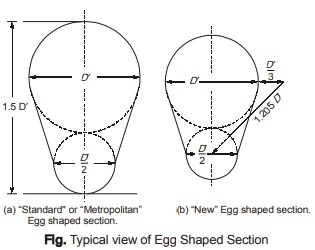Egg Shaped Sewer
Egg Shaped Sewer Section
- Circular sewer sections are mostly used for separate sewage system. However, other forms of sewer section such as egg shape horse shoe shape, parabolic shape, rectangular shape, semi-elliptical shape etc. may be used.
- The circular sections are generally preferred to all other shapes because of their following advantages:
- They can be manufactured most easily and conveniently.
- A circular sewer provides the maximum area for a given perimeter and thus providing the maximum
hydraulic mean depth when running full or half full, and is therefore, the most efficient section of these flow conditions. - Circular section utilizes the minimum quantities of materials and is therefore the cheapest and most economical.
- A circular section, being of uniform curvature all round, offers less opportunities for deposits.
- All these advantages of circular sections are obtained only when the sections runs at least half full. When the depth goes below half depth the velocity reduces considerably.
- If a circular sewer is used for combined system it will be effective only during maximum rain water flow but during dry weather flow, velocity generated would be very less. Thus to take advantage of a circular sewer, two such circular sewer are assumed to be combined into one to form an “egg shaped sewer” in which smaller circular portion will be effective during dry weather and full section is effective during maximum rain water flow. Egg shaped sewers maintain hydraulic depth nearly uniform and gives 2 to 15% higher velocities than provided by hydraulically equivalent circular sections carrying the same discharge.
- Two sewers of different shapes are said to be hydraulically equivalent when they discharge at the same rate, while flowing full, on the same grade.

As the increase in velocity is quite small compared to their disadvantages and therefore such sewers, which are quite often used in old days, are becoming obsolete these days. Their disadvantage over circular sewers are:
(i) They are more difficult to construct.
(ii) Since the smaller base has to support weight of upper broader section, they are less stable.
(iii) They require more material and thus are costly.
As the computation of wetted area and wetted perimeter of such sewers is very difficult, therefore while designing such sewers, the usual practice is to calculate the approximate diameter of a hydraulically equivalent circular sewer first, which would give same discharge when running full at same gradient and then to convert it into dimensions of an egg shaped section having an equal area.
For computing egg shaped sewer of an equivalent section, diameter of circular section (D) is multiplied by a constant factor (i.e. 0.84) so as to get top horizontal diameter width (D ′) of egg shaped section i.e. D′ = 0.84D
where,
D ′ = Width of egg shape section.
D = Diameter of circular sewer of same cross-sectional area for required discharge
<< Previous | Next >>
Must Read: What is Environmental Engineering?

